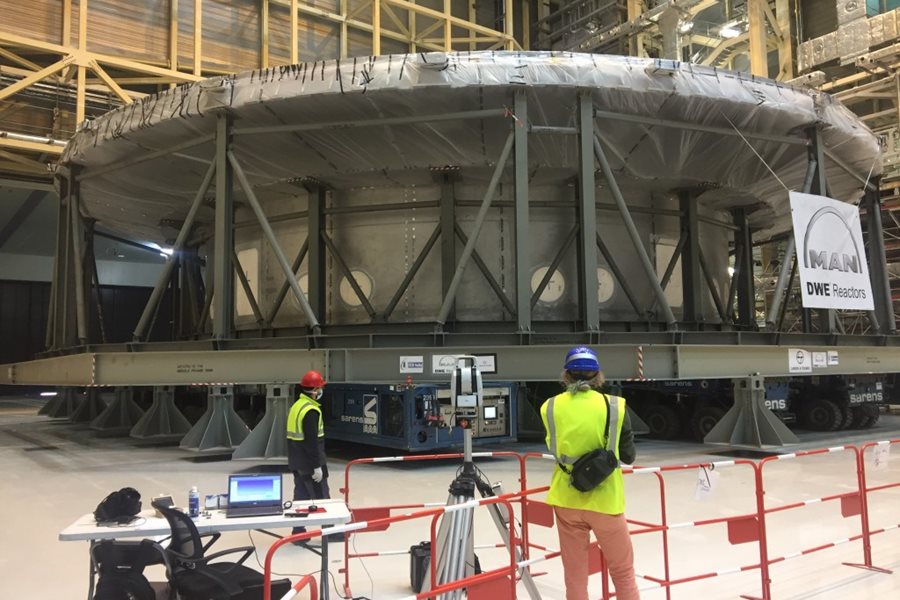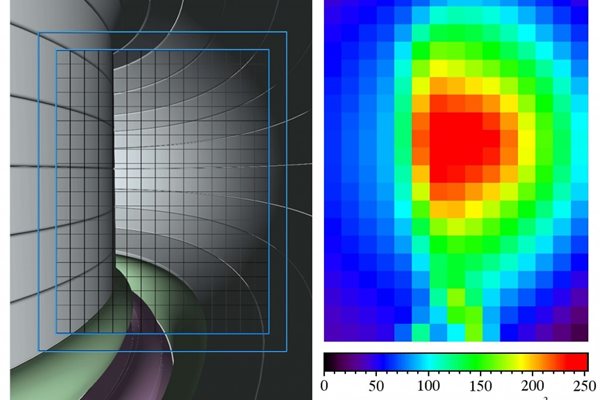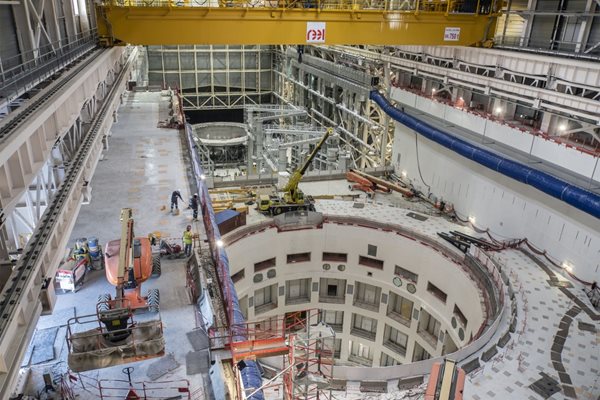
you're currently reading the news digest published from 28 Apr 2020 to 04 May 2020
featured3
video1
press12
featured
Assembly | ITER's reliance on metrology, the science of measurement
Over the next four years, ITER components arriving from hundreds of factories on three continents will have to come together very precisely—to submillimetre accuracy, in some cases. To achieve this level of precision, an expert team of metrologists is needed. John Villanueva is one of the experts of the ITER Metrology, Reverse Engineering, Inspection and Test Group. 'I became involved in metrology long enough ago that I'm now one of the old-timers,' he says. 'I've gone from using the old-fashioned optical-mechanical scopes all the way to the laser trackers we use today. It's because I lived through those changes that I can more easily understand why we do what we do today.' Aligning huge parts to the ITER coordinate system All measurement tasks require a fixed reference base from which measurements can be made and calculated. As a large-scale metrology project, ITER has a three-dimensional coordinate system that consists of a collection of target "nests" and/or instrument stations that have known geometry and computed uncertainty. Inside the Tokamak Complex, the network is called the Tokamak Global Coordinate System. 'When you go into the Tokamak Building you'll see our red targets all over the building,' says Villanueva. 'We can use a tool to shoot any three targets, and by the magic of Pythagorean's Theorem we know precisely where the centre of our instrument is with respect to the Tokamak Global Coordinate System.' The tool includes a horizontal angle encoder, a vertical angle encoder, and a laser to obtain distance. With the two angles and the distance, a triangle can be established. 'We recently had 340-tonne test loads going into one of the sector sub-assembly tools in the Assembly Hall, that had to be positioned vertical to gravity and within one millimetre,' says Villanueva. 'They had to be vertical to gravity for safety reasons, but also because—as part of commissioning—we had to prove that the tool could align huge parts vertical to gravity with tight accuracy.' "The sector sub-assembly tools have six degrees of freedom—and along each degree of freedom, the instruments used for metrology can measure submillimetre movements. Metrology is there, watching the component aligned onto the tool and telling the teams if it's aligned in the right position." Metrology is not only about aligning components during installation, but also measuring each part to make sure it has been manufactured as designed. Accompanying each measure is an uncertainty, or tolerance. To make sure mechanical engineers and metrologists understand each other unambiguously, a standard 'language' is used, called geometric dimensioning and tolerancing (GDT). 'I can take a part somewhere else and they'll measure it exactly the way I'm measuring it by interpreting this language,' explains Villanueva. 'This system allows us to compare what was manufactured with what was designed.'Controlling temperature and humidity When metrologists measure components, they need to take into account a coefficient of thermal expansion, which depends on the materials used. When composite materials are used, the component may expand differently on the inside than on the outside, because the individual materials have different rates of expansion. Some of the ITER machine components are so big that a one-degree change of temperature could add a millimetre in any of the three dimensions (or in all three), changing both surface area and volume. 'Before we measure a part, we take its temperature,' says Villanueva. 'If it's not at 20 °C, we use software to find out what the size of that part would be at 20 °C. There are a number of different software systems that do this. You input the temperature and measurements, along with the types of materials used, and the software figures out the size and volume of that component at room temperature.' 'When it comes time to install these huge, high-precision parts, temperature is very important. If the component is not at 20 °C, plus or minus half a degree, we have to let it 'soak' in the room for about a day to get it to the temperature we need.' Humidity is also a concern: too much causes parts to rust; too little gives rise to static electricity. Moreover, the performance of the laser used for positioning and measurement could be affected by extreme humidity—that is, anything outside the 'normal' range of 20-90%. Measurement precision is one of the reasons ITER puts so much effort into maintaining constant temperature and humidity in the assembly spaces. To prevent outside weather conditions from affecting the environment inside, the buildings are well insulated—and positive airflow ensures none of the air from outside comes in when doors are opened. As an extra precaution, alarm systems alert engineers to fluctuations in temperature and humidity. Environmental conditions are just part of the challenge. The size of the overall project, the sizes of the systems and component parts, along with the precision requirements and the complexity of the materials, all conspire to make ITER particularly interesting for practitioners of the science of measurement. 'For a metrologist, ITER is one of the best jobs in the world,' says Villanueva.
Diagnostics | Scientist Fellows in action
Important contributions are being made to ITER diagnostics by the 22 ITER Scientist Fellows who are currently dedicating a portion of their time to the research and development needs of the Port Plugs & Diagnostics Division. Since 2016, scientists and engineers from the ITER Members have been nominated by their home institutes to become part of the ITER Scientist Fellow Network. Fellows agree to an annual work plan in an area of interest that matches an ITER need, and work closely throughout their term with ITER specialists. Of the 60 scientists participating in the Network today, 22 are supporting ITER's Port Plugs & Diagnostics Division. 'ITER diagnostics are benefitting immensely from the involvement of the broader scientific and technical community of the ITER Members directly in development work, while the Fellows gain access to cutting-edge research topics that can enrich their work back home,' says Division Head Michael Walsh. More than 40 types of diagnostics—55 instruments in all—are planned to provide ITER operators with detailed information during plasma operation. Because of the harsh environment inside the vacuum vessel, these systems must cope with a range of phenomena not previously encountered in tokamak diagnostics, while performing with great accuracy and reliability. The following paragraphs portray a small sample of the kind of important work that is being done across the board by the ITER Scientist Fellows in diagnostics. Artur Malaquias, from the Instituto Superior Técnico in Lisbon, Portugal, is contributing to the effort to develop advanced detectors for the radial X-ray camera diagnostic in close collaboration with the Chinese Domestic Agency (and China's ASIPP institute). Similar to a CAT scan, these detectors will provide a detailed view inside the ITER plasma, gathering information on important plasma properties such as impurity content, temperature and the presence of any unwanted high-energy electron beams. Although the operation of X-ray detectors is well documented in other fusion experiments, the ITER nuclear environment—with levels of neutron flux several orders of magnitude higher than any tokamak today—brings new challenges. With experts from all of the ITER parties working on the design of advanced detectors, one of the most effective ways to bring this knowledge to bear fruit is to structure dedicated workshops, and Artur has organized several. Experimental results as well as modelling and simulations provided valuable clues on how to blend the physics requirements and engineering solutions into a sensitive yet rugged and nuclear-proof design. American native Byron Peterson has been working in fusion research in Japan for the last 25 years. He is currently professor of imaging diagnostics at SOKENDAI (the Graduate School for Advanced Studies), and at the National Institute for Fusion Science where he drives the bolometer diagnostics on the Large Helical Device (LHD). Bolometers measure the power lost from the plasma through electromagnetic radiation ranging from infrared to X-ray. Over 100 bolometer sensors—with a total of around 500 lines of sight—survey the ITER plasma from strategic locations inside the vacuum vessel. In collaboration with ITER staff and other Fellows, Peterson is evaluating the effects of neutrons and the signal-to-noise ratio of prospective imaging bolometers. A team of researchers at the Australian National University, led by professor emeritus John Howard, has developed innovative optical systems that allow the imaging of plasma flows and temperature in the exhaust regions of fusion plasmas. These plasma Doppler 'radar guns' tell us how fast the hot escaping plasma is funnelling into the ITER divertor—important information for checking wall heat loads while also allowing the tracking of eroded impurity material. Doppler 'coherence imaging' (CI) systems are now operating on the largest and most advanced fusion experiments around the world. A Cooperation Agreement between the Australian Nuclear Science and Technology Organisation (ANSTO) and the ITER Organization underpins the installation of the Doppler CI system in an equatorial port on ITER for imaging the plasma boundary and divertor areas. A successful conceptual design review in March 2019 should help secure a long-term Australian commitment to this important ITER diagnostic. Gary Taylor has been working as an ITER Scientist Fellow for the past two years, mostly to guide the design of the electron cyclotron emission (ECE) diagnostic—a key microwave diagnostic that will be used to study the time evolution of the electron temperature profile and plasma instabilities in ITER. (The ECE diagnostic is being developed in a collaboration between design teams in the US and India.) Gary has more than 40 years of experience working in nuclear fusion research at the Princeton Plasma Physics Laboratory in the US and has led the US ECE design team for the past seven years. A critical component in the ECE system is the diagnostic shield module located in an equatorial port plug at the front of the diagnostic. In addition to other components, the module contains two hot calibration sources (see gallery below) that must operate reliably at temperatures up to 800 °C in the harsh physical environment of the ITER vacuum vessel. In addition to working on the ECE diagnostic, Gary has served as an expert on several ITER design review panels.
Image of the week | Preparing for a momentous event
A large circular opening in the foreground where the ITER machine will be assembled piece by piece; a large circular structure in the background—the first piece to be inserted. The lowering of the cryostat base this month will mark the symbolic beginning of the machine assembly phase. At both ends of the vast 'assembly theatre,' teams are busy preparing for this momentous event. A permanent protective fence is being erected around the rim of the Tokamak pit, partly made of see-through panels to allow specialists to closely monitor the descent of the 1,250-tonne component. At the bottom of the pit, specialists from the European Domestic Agency are adjusting and adapting the last plates of the cryostat's vertical skirt support. At the other end of the theatre, workers from the CNPE consortium have begun grooming the base section for the upcoming operations. In a few days the component, properly rigged out, will be lifted a few centimetres to verify that all the functions are behaving as defined and expected. The big lift is scheduled at the end of the month—a first-of-a-kind operation for a first-of-a-kind component.



